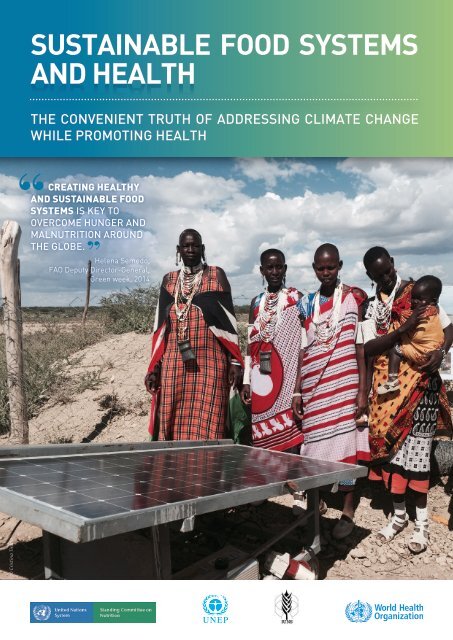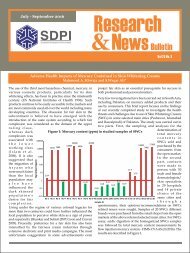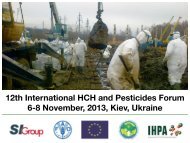SUSTAINABLE FOOD SYSTEMS AND HEALTH
EXE_2_Sustainable_Food_systems_and_health
EXE_2_Sustainable_Food_systems_and_health
Create successful ePaper yourself
Turn your PDF publications into a flip-book with our unique Google optimized e-Paper software.
<strong>SUSTAINABLE</strong> <strong>FOOD</strong> <strong>SYSTEMS</strong><br />
<strong>AND</strong> <strong>HEALTH</strong><br />
THE CONVENIENT TRUTH OF ADDRESSING CLIMATE CHANGE<br />
WHILE PROMOTING <strong>HEALTH</strong><br />
CREATING <strong>HEALTH</strong>Y<br />
<strong>AND</strong> <strong>SUSTAINABLE</strong> <strong>FOOD</strong><br />
<strong>SYSTEMS</strong> IS KEY TO<br />
OVERCOME HUNGER <strong>AND</strong><br />
MALNUTRITION AROUND<br />
THE GLOBE.<br />
Helena Semedo,<br />
FAO Deputy Director-General,<br />
Green week, 2014<br />
© Cristina Tirado
© Lina Mahy<br />
© Javier von der Pahlen<br />
TACKLING CLIMATE CHANGE:<br />
THE GREATEST OPPORTUNITY<br />
FOR GLOBAL <strong>HEALTH</strong>.<br />
(Lancet 2015)<br />
WHY WE NEED ACTION NOW<br />
FEEDING THE WORLD SUSTAINABLY <strong>AND</strong> PROMOTING<br />
GOOD NUTRITION <strong>AND</strong> <strong>HEALTH</strong> UNDER A CHANGING<br />
CLIMATE IS ONE OF THE MAIN CHALLENGES OF OUR TIME.<br />
More than half of the world’s 7 billion people is affected by a form of<br />
malnutrition. Despite the abundance of food supplies, there are still 795<br />
million persons that go hungry every day (FAO, IFAD, WFP, 2015). This<br />
affects their ability to work, it negatively impacts the development of<br />
their children, exposes them to illness and leads to premature deaths.<br />
Approximately 24 percent of children under five years of age are stunted<br />
(UNICEF, WHO World Bank, 2015). The health of two billion people is<br />
compromised by nutrient deficiencies and 1.9 billion adults are overweight<br />
or obese (WHO, 2015).<br />
Climate change has a negative impact oon food and nutrition security and<br />
the health of millions of vulnerable people, particularly poor women and<br />
children. According to the Intergovernmental Panel of Climate Change<br />
(IPCC), if current trends continue, it is estimated that an additional<br />
1-3 billion people will be affected by water scarcity and 200-600 million<br />
will suffer from hunger by 2080 particularly in sub-Saharan African<br />
countries.<br />
The global food system will be further challenged over the coming<br />
decades with increases in the human population, changes in diet, climate<br />
change and greater demands on energy and water resources (Godfray et<br />
al., 2010). Between now and 2050, the world’s population will increase by<br />
one-third and most of the additional 2 billion people will live in developing<br />
countries. Rapidly urbanizing areas in sub-Saharan Africa and South Asia<br />
could become potential food insecurity hotspots (FAO, 2009). Changes in<br />
dietary patterns towards more production and consumption of meat and<br />
animal products present a set of complex challenges for climate change<br />
mitigation, for agriculture, for health and for achieving food and nutrition<br />
security (FAO, 2009; Tirado et al., 2013; Tilman and Clark, 2014). Meat and<br />
animal products provide important sources of proteins, minerals and<br />
vitamins but overconsumption is associated with an increased risk of noncommunicable<br />
diseases (NCDs) such as heart disease, type-2 diabetes<br />
and certain types of cancer (Bouvard et al. , 2015; Wellesley, Happer and<br />
Froggatt, 2015).<br />
Projections show that feeding a world population of 9 billion people in<br />
2050 would require raising overall food production by some 60% (FAO,<br />
2012). High food output achieved in the past has placed great stress on<br />
natural resources. The agriculture sector specifically is a major source<br />
of greenhouse gas (GHG) emissions. Agriculture, forestry and associated<br />
land use and land use change contribute to 20 to 30 percent of the total<br />
anthropogenic GHG emissions (Tubiello et al., 2014; 2015). The expansion<br />
of livestock and biofuel sectors plays a major role in deforestation<br />
and land degradation and contributes to climate change. Other GHG<br />
emissions stem from fossil fuel use in the field as well as from across<br />
the whole food system continuum, such as food transport, storage, cold<br />
chains, processing, and food loss and waste. Furthermore, globally<br />
about one-third of food produced for human consumption per year is<br />
lost or wasted. (Gustavsson et al., 2011; Vermeulen et al. , 2012).<br />
Although health is one of the three main aims of the original UN Framework<br />
Convention for Climate Change (UNFCCC) (article 1) 1 in 1992, on equal<br />
level with natural environment and economy, it has been neglected by the<br />
climate discussions ever since. Safeguarding food production is part of<br />
the ultimate objective of the UNFCCC (article 2), yet health, food security<br />
and nutrition considerations are weak (food security and health) or absent<br />
(nutrition) within the current narrative of the UNFCCC Ad Hoc Working<br />
Group on the Durban Platform for Enhanced Action.<br />
The challenge today is to sustainably improve nutrition and health through<br />
implementation of coherent policies and better coordinated actions<br />
across all relevant sectors, strengthening, preserving and recovering<br />
healthy and sustainable food systems (FAO, WHO 2014).<br />
1 - https://unfccc.int/resource/docs/convkp/conveng.pdf<br />
2<br />
Sustainable Food Systems and Health: The convenient truth of addressing climate change while promoting health
OPPORTUNITIES<br />
TO ADDRESS<br />
THESE CHALLENGES<br />
The Rome Declaration on Nutrition, adopted by Member States at the FAO,<br />
WHO Second International Conference on Nutrition (ICN2) recognizes the<br />
need to address the impacts of climate change and other environmental<br />
factors on food security and nutrition, in particular on the quantity, quality<br />
and diversity of food produced, taking appropriate action to tackle negative<br />
effects (FAO, WHO, 2014).<br />
The ICN2 Framework for Action provides policy options and actions<br />
for sustainable food systems promoting healthy diets (FAO, WHO, 2014)<br />
including:<br />
• To review national policies and investments and integrate nutrition<br />
objectives into food and agriculture policy, programme design and<br />
implementation, to enhance nutrition sensitive agriculture, ensure<br />
food security and enable healthy diets.<br />
• To strengthen local food production and processing, especially by<br />
smallholder and family farmers, giving special attention to women’s<br />
empowerment, while recognizing that efficient and effective trade is<br />
key to achieving nutrition objectives.<br />
• To promote the diversification of crops including underutilized<br />
traditional crops, more production of fruits and vegetables, and<br />
appropriate production of animal-source products as needed,<br />
applying sustainable food production and natural resource<br />
management practices.<br />
• To improve storage, preservation, transport and distribution<br />
technologies and infrastructure to reduce seasonal food insecurity,<br />
food and nutrient loss and waste.<br />
• To establish and strengthen institutions, policies, programs and<br />
services to enhance the resilience of the food supply in crisis-prone<br />
areas, including areas affected by climate change.<br />
The ICN2 commitments offer a unique opportunity to address the impacts<br />
of climate on nutrition and to promote the co-benefits of sustainable and<br />
healthy dietary patterns to health and the environment.<br />
Sustainable Development Goal 2 (SDG2) to “end hunger, achieve food<br />
security and improved nutrition and promote sustainable agriculture”<br />
commits Member States to end hunger and to achieve food security and<br />
to end all forms of malnutrition as a matter of priority. SDG12 requests<br />
Member States to ensure sustainable consumption and production patterns<br />
and SDG13 urges them to take urgent action to combat climate change<br />
and its impacts while acknowledging that the United Nations Framework<br />
Convention on Climate Change (UNFCCC) is the primary international,<br />
intergovernmental forum for negotiating the global response to climate<br />
change.<br />
The mandates are identified, the commitments are made to address the<br />
impacts of climate change on health and nutrition; these commitments<br />
should now be integrated in the climate change agenda and climate funding<br />
mechanisms at national and international levels.<br />
A <strong>SUSTAINABLE</strong> <strong>FOOD</strong> SYSTEM IS A <strong>FOOD</strong><br />
SYSTEM THAT ENSURES <strong>FOOD</strong> SECURITY <strong>AND</strong><br />
NUTRITION FOR ALL IN SUCH A WAY THAT THE<br />
ECONOMIC, SOCIAL <strong>AND</strong> ENVIRONMENTAL BASES<br />
TO GENERATE <strong>FOOD</strong> SECURITY <strong>AND</strong> NUTRITION OF<br />
FUTURE GENERATIONS ARE NOT COMPROMISED.<br />
(HLPE, 2014)<br />
KEY MESSAGES<br />
› <strong>SUSTAINABLE</strong> <strong>AND</strong> <strong>HEALTH</strong>Y DIETS CAN CONTRIBUTE TO BOTH A<br />
REDUCTION IN GHG EMISSIONS <strong>AND</strong> IMPROVED PUBLIC <strong>HEALTH</strong> <strong>AND</strong><br />
NUTRITIONAL OUTCOMES. It is necessary to reshape food access and<br />
consumption patterns to ensure nutrient requirements of all age groups<br />
and all groups with special nutrition needs are met and to foster healthy and<br />
sustainable eating patterns worldwide. The IPCC AR5 report highlighted<br />
the opportunities to achieve co-benefits from actions that reduce<br />
emissions and at the same time improve health by shifting consumption<br />
away from animal products, especially from ruminant sources, in highmeat<br />
consumption societies, toward less emission intensive healthy<br />
diets. Sustainable and healthy diets can be realized by developing a food<br />
system that embraces fundamental values such as: establishing a culture<br />
of healthy living, embracing equitable solutions, supporting universal food<br />
security; encouraging active citizenship to steward natural resources and<br />
transparency (DGAC, 2015). These values need to be incorporated in the<br />
health, nutrition, food, education, agriculture, water, energy, transport and<br />
environmental sectors as well as taken into account when establishing<br />
robust and transparent private and public sector partnerships.<br />
› ENHANCE <strong>SUSTAINABLE</strong> <strong>FOOD</strong> <strong>SYSTEMS</strong> BY DEVELOPING COHERENT<br />
PUBLIC POLICIES FROM PRODUCTION TO CONSUMPTION <strong>AND</strong> ACROSS<br />
RELEVANT SECTORS TO PROVIDE YEAR-ROUND ACCESS TO <strong>FOOD</strong><br />
THAT MEETS PEOPLE’S NUTRITION NEEDS <strong>AND</strong> PROMOTE SAFE<br />
<strong>AND</strong> DIVERSIFIED <strong>HEALTH</strong>Y DIETS. Since food systems have become<br />
increasingly complex and strongly influence people’s ability to consume<br />
healthy diets, coherent action and innovative food system solutions are<br />
needed to ensure access to sustainable, balanced and healthy diets for<br />
all. Special attention needs to be paid to the promotion of breastfeeding:<br />
it provides safe and nutritious food all year-round for infants and young<br />
children. Breastmilk is the ideal food under all circumstances but can<br />
be particularly beneficial in times of emergencies due to its availability,<br />
affordability and safety. Breastmilk is a natural and renewable food that<br />
involves no packaging, transportation or fuel to prepare and therefore<br />
contributes to environmental sustainability (UNICEF, 2015). The ICN2<br />
Framework for Action recommendations, adopted by the FAO and WHO<br />
member states, propose policy options and actions to be implemented.<br />
Agreement on shared principles of sustainability in promoting healthy diets<br />
is needed (FAO, WHO, 2014).<br />
› PROMOTE <strong>SUSTAINABLE</strong> PRODUCTION <strong>AND</strong> CONSUMPTION IN <strong>FOOD</strong><br />
<strong>SYSTEMS</strong> <strong>AND</strong> AGRICULTURE. This concept refers to the integrated<br />
implementation of sustainable patterns of food production and<br />
consumption, respecting the carrying capacities of natural ecosystems. It<br />
requires consideration of all the aspects and phases in the life of a product,<br />
from production to consumption, and includes such issues as sustainable<br />
lifestyles, sustainable diets, food losses and food waste management and<br />
recycling, voluntary sustainability standards, and environmentally-friendly<br />
behaviours and methods that minimize adverse impacts on the environment<br />
and do not jeopardize the needs of present and future generations<br />
(FAO,UNEP, 2014). A practical way to realize this concept is to upscale the<br />
use and entrench into relevant policies, Ecosystems Based Adaptation<br />
approaches (EBA) to food production, and link these to sustainable value<br />
chain processes such as clean energy powered food processing in a<br />
continuum (UNEP, 2012).<br />
› NUTRITION-SENSITIVE CLIMATE ADAPTATION <strong>AND</strong> MITIGATION HAS<br />
MANY CO-BENEFITS FOR BOTH <strong>HEALTH</strong> <strong>AND</strong> THE ENVIRONMENT.<br />
ADDRESS <strong>FOOD</strong> <strong>AND</strong> NUTRITION SECURITY IN THE NATIONAL ADAPTATION<br />
PLANS (NAPs) <strong>AND</strong> NATIONALLY APPROPRIATE MITIGATION ACTION<br />
PLANS (NAMAS). A combination of nutrition-sensitive, climate-smart<br />
strategies and technological development, nutrition-smart investments in<br />
the agriculture and food sectors but also in social protection, education and<br />
community-based disaster risk reduction areas can contribute to ensure<br />
food and nutrition security in a changing climate (Tirado et al., 2013). Policy<br />
coherence needs to be ensured through institutional and cross-sectoral<br />
collaboration.<br />
› ADOPT A MULTI-SECTORAL APPROACH <strong>AND</strong> GOOD GOVERNANCE.<br />
Reaching and sustaining food and nutrition security in a changing climate<br />
requires a multi-sectoral food system approach involving nutrition,<br />
agriculture, health, trade, education, water supply and sanitation and social<br />
protection, as well as taking into account cross-cutting issues like gender<br />
equality, governance, and state fragility.<br />
Sustainable Food Systems and Health: The convenient truth of addressing climate change while promoting health 3
AKNOWLEDGMENTS<br />
This brief has been written by Cristina Tirado, UCLA as background information for the side event organized by IUNS, FAO,<br />
UNSCN and WHO at COP21, on 7 December 2015.<br />
The contributions of the following individuals are gratefully acknowledged: Lina Mahy (UNSCN), Carlos Dora and Francesco<br />
Branca (WHO), Alexandre Meybeck and Anna Lartey (FAO), Juliette Biao Koudenoukpo (UNEP).<br />
© Cristina Tirado<br />
REFERENCES<br />
• Bouvard V, Loomis D Guyton KZ, Grosse Y, El Ghissassi F, Benbrahim-Tallaa L, Guha N, Mattock<br />
H, Straif K (2015) Carcinogenicity of consumption of red and processed meat, on behalf of the<br />
International Agency for Research on Cancer Monograph Working Group, International Agency for<br />
Research on Cancer, Lyon, France Lancet Oncology Published Online October 26, 2015 http://dx.doi.<br />
org/10.1016/S1470-2045(15)00444-1 accessed 29 November 2015<br />
• Dietary Guidelines Advisory Committee (2015) Scientific Report of the 2015 Dietary Guidelines<br />
Advisory Committee: Advisory Report to the Secretary of Health and Human Services and the<br />
Secretary of Agriculture.<br />
• FAO,WHO Second International Conference on Nutrition (2014) Conference Outcome Document:<br />
Framework for Action. Rome, 2014. http://www.fao.org/3/a-mm215e.pdf<br />
• FAO (2008) Climate Change and Food Security: A Framework Document. Rome: FAO, 2008.<br />
• FAO (2009) The state of food and agriculture: livestock in the balance. Available at: http://www.fao.<br />
org/docrep/012/i0680e/i0680e00.htm. Accessed 24 September 2013.<br />
• FAO(2012) World agriculture towards 2030/2050 the 2012 revision. ESA Working Paper No. 12-<br />
03 (Nikos Alexandratos and Jelle Bruinsma) Global Perspective Studies Team FAO Agricultural<br />
Development Economics Division.<br />
• FAO (2015) Climate Change and Global Food Systems: global assessments and implications for food<br />
security and trade. (A. Elbehri, Ed.). Rome, Italy: Food and Agriculture Organization of the United Nations.<br />
• FAO,UNEP (2014) The FAO-UNEP Sustainable Food Systems Programme.<br />
http://www.fao.org/fileadmin/templates/ags/docs/SFCP/Flyer_EN_01.pdf<br />
• FAO, IFAD and WFP (2015) The State of Food Insecurity in the World 2015. Meeting the 2015<br />
international hunger targets: taking stock of uneven progress. Rome, FAO.<br />
• Friel S, Dangour AD, Garnett T, Lock K, Chalabi Z, Roberts (2009) Public health benefits of strategies<br />
to reduce greenhouse-gas emissions: food and agriculture. Lancet 374:2016–25.<br />
• Godfray HCJ, Beddington JR, Crute IR, Haddad L, Lawrence D, Muir J, Pretty J, Robinson S, Thomas S,<br />
Toulmin C (2010) Food security: the challenge of feeding 9 billion people. Science, 327(5967), 812-818.<br />
• Gustavsson J, Cederberg C, Sonesson U, van Otterdijk R, Meybeck A (2011) Global food losses and<br />
food waste. Rome: Food and Agriculture Organization of the United Nations.<br />
• HLPE (2014) Food losses and waste in the context of sustainable food systems. A report by the High<br />
Level Panel of Experts on Food Security and Nutrition of the Committee on World Food Security,<br />
Rome 2014.<br />
• Intergovernmental Panel on Climate Change (2014) Summary for policymakers. In Climate Change<br />
2014: Mitigation of Climate Change. Contribution of Working Group III to the Fifth Assessment<br />
Report of the Intergovernmental Panel on Climate Change (pp. 1–31).<br />
• Tilman D, Clark M (2014) Global diets link environmental sustainability and human health. Nature<br />
2014 Nov 27;515(7528):518-22. doi: 10.1038/nature13959<br />
• Tubiello FN, Salvatore M, Golec RDC, Ferrar A, Rossi S, Biancalani R, Federici S, Jacobs H, Flammini A<br />
(2014) Agriculture, Forestry and Other Land Use Emissions by Sources and Removals by Sinks: 1990-<br />
2011 Analysis. FAO Statistics Division, ESS Working Paper No. 2, Mar 2014. 76p.<br />
• Tubiello FN, Salvatore M, Ferrara AF, House J, Federici S, Rossi S, Biancalani R, Golec RDC, Jacobs<br />
H, Flammini A, Prosperi P, Cardenas-Galindo P, Schmidhuber J, Sanchez MJS, Srivastava N, Smith P<br />
(2015) The Contribution of Agriculture, Forestry and other Land Use activities to Global Warming,<br />
1990-2012. Global Change Biology (2015) http://dx.doi.org/10.1111/gcb.12865<br />
• Tirado MC, Crahay P, Mahy L, Zanev C, Neira M, Msangi S, Brown R, Scaramella C, Costa Coitinho<br />
D, Müller A (2013) Climate change and nutrition: creating a climate for nutrition security. Food &<br />
Nutrition Bulletin, 34(4), 533-547.<br />
• UNEP (2012) Ecosystem-based Adaptation Guidance Moving from Principles to Practice. Working<br />
Document April 2012 http://www.unep.org/climatechange/adaptation/Portals/133/documents/<br />
Ecosystem-Based%20Adaptation/Decision%20Support%20Framework/EBA%20Guidance_<br />
WORKING%20DOCUMENT%2030032012.pdf<br />
• UNICEF (2015) A Post-2015 World Fit for Children. Issue Brief: Breastfeeding. August 2015. New York<br />
• UNICEF, WHO, World Bank Group (2015) Levels and trends in child malnutrition http://www.who.<br />
int/entity/nutgrowthdb/jme_brochure2015.pdf?ua=1<br />
• Vermeulen SJ, Campbell BM, Ingram JSI (2012) Climate change and food systems. Annu. Rev.<br />
Environ. Resource 37, 195–222 (2012).<br />
• Wang H, Horton R (2015) Tackling climate change: the greatest opportunity for global health.<br />
Lancet 386:10006, p1798–1799.<br />
• Wellesley L, Happer C, Froggatt A (2015) Changing Climate, Changing Diets Pathways to Lower<br />
Meat Consumption. Chatham House Report. The Royal Institute of International Affairs. London<br />
• World Health Organization (2015) Overweight and obesity fact sheet N°311 http://www.who.int/<br />
mediacentre/factsheets/fs311/en/, accessed 29 November 2015<br />
Sustainable Food Systems and Health: The convenient truth of addressing climate change while promoting health







